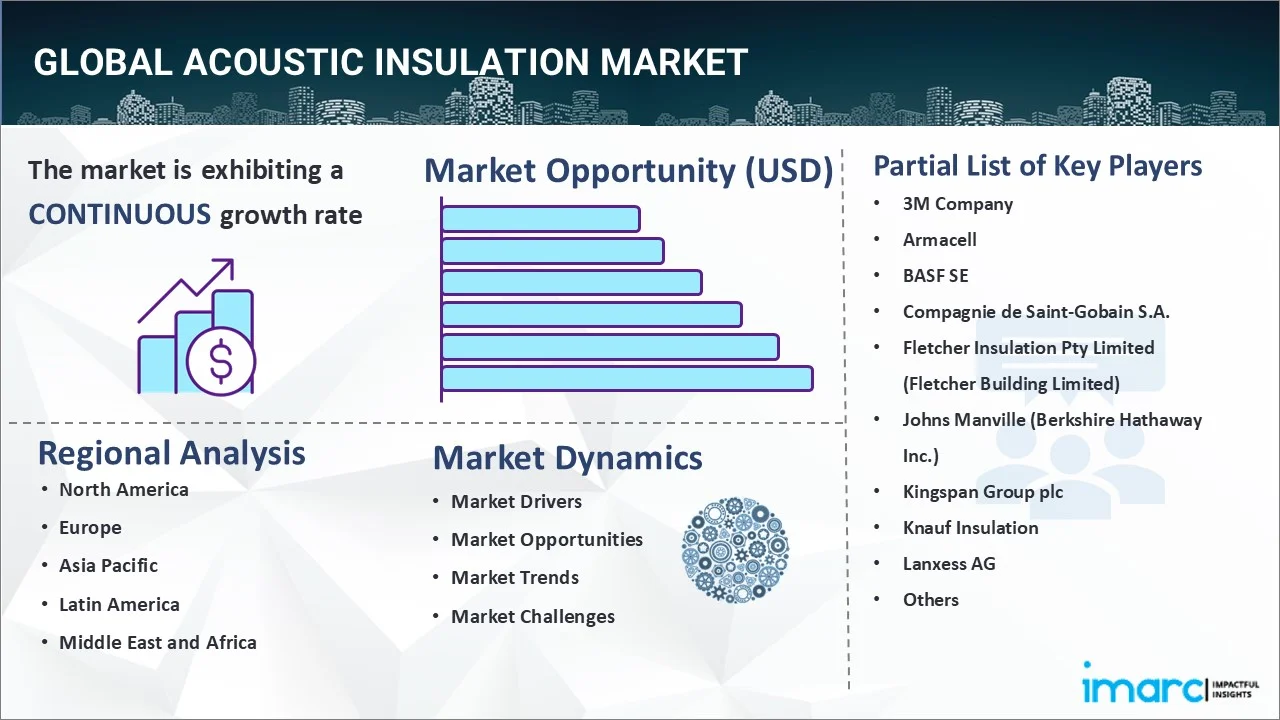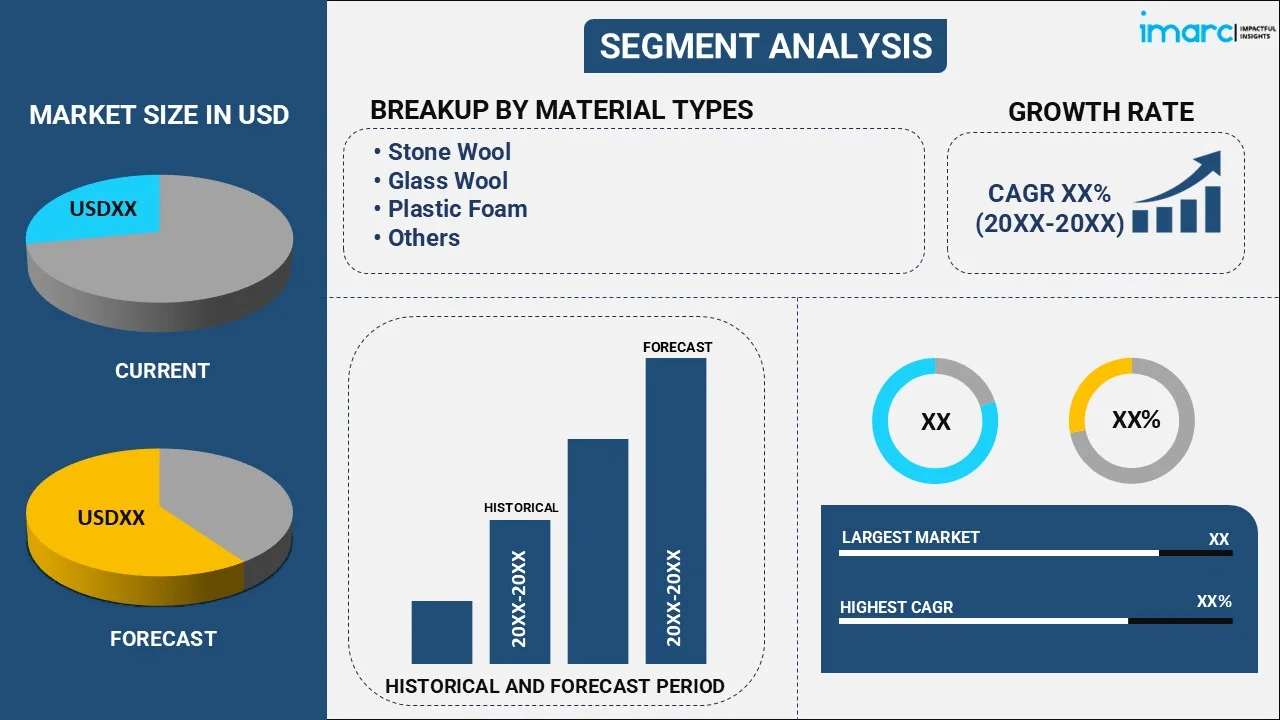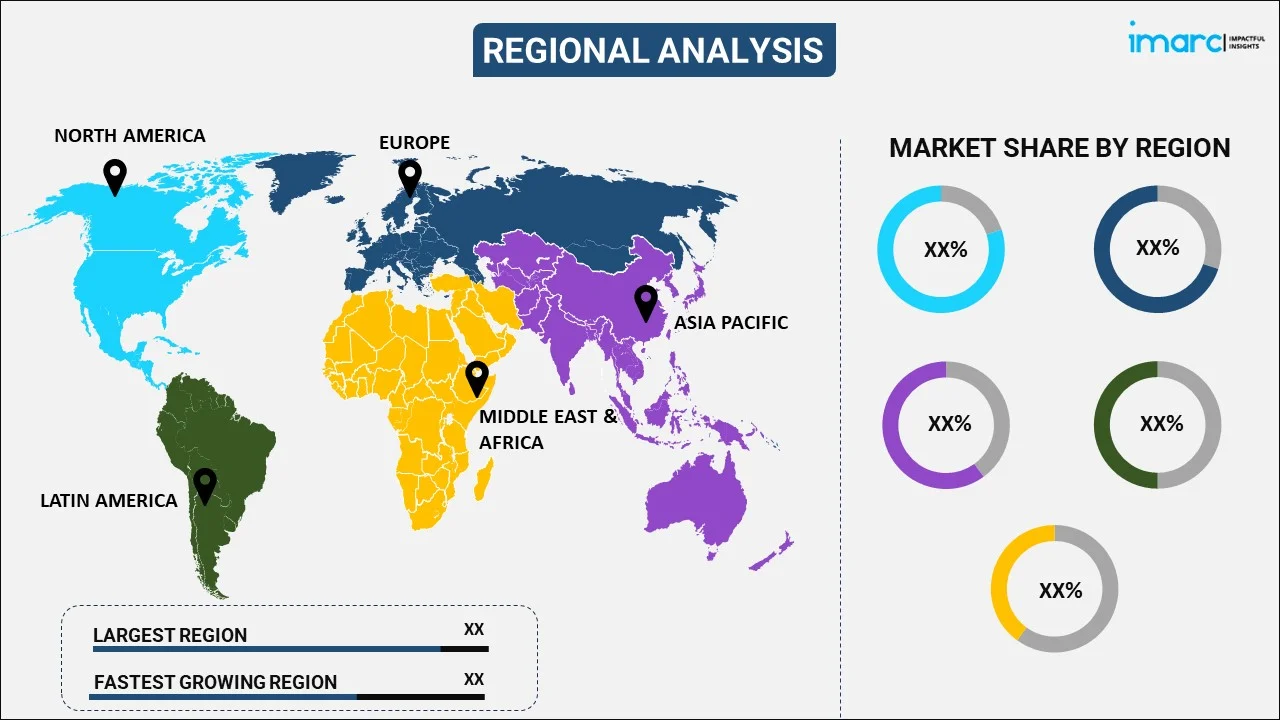
Acoustic Insulation Market Report by Material Type (Stone Wool, Glass Wool, Plastic Foam, and Others), Sales Channel (Offline, Online), End User (Building and Construction, Industrial, Transportation), and Region 2025-2033
Acoustic Insulation Market Size:
The global acoustic insulation market size reached USD 15.7 Billion in 2024. Looking forward, the market is expected to reach USD 23.4 Billion by 2033, exhibiting a growth rate (CAGR) of 4.5% during 2025-2033. The market is majorly driven by the rising product demand in the construction sector and increasing incorporation of insulation materials in vehicles. Moreover, stringent regulatory policies for noise control are chiefly fueling the demand for soundproofing materials. This, in turn, is facilitating the demand for acoustic insulation, thereby contributing to the market growth.
|
Report Attribute
|
Key Statistics
|
|---|---|
|
Base Year
|
2024 |
|
Forecast Years
|
2025-2033
|
|
Historical Years
|
2019-2024
|
| Market Size in 2024 | USD 15.7 Billion |
| Market Forecast in 2033 | USD 23.4 Billion |
| Market Growth Rate (2025-2033) | 4.5% |
Acoustic Insulation Market Analysis:
- Major Market Drivers: Some of the major market drivers of the global acoustic insulation market include escalating urbanization leading to proliferating construction activities, strict building regulations requiring noise control, and rising awareness of the adverse health effects of noise pollution. The automotive industry's goal for enhanced noise reduction and passenger comfort also substantially contributes to shaping global acoustic insulation market outlook. In addition to this, the sales of eco-friendly insulation material are notably fueled by the intensifying inclination towards sustainable construction methods. Consequently, these drivers propel the demand for advanced acoustic insulation solutions across industrial, residential, and commercial sectors.
- Key Market Trends: The principal market trends in the global acoustic insulation market include the rising product demand in the construction sector, driven by strict noise control regulations and urbanization. The automotive industry also plays a pivotal role in the acoustic insulation market dynamics as manufacturers are actively striving to enhance vehicle convenience and address noise reduction protocols. In addition to this, there is a notable inclination towards eco-friendly and sustainable products, primarily due to increasing environmental awareness and customer preferences for green building solutions. Moreover, technological advancements and innovations are aiding in structuring positive acoustic insulation market outlook.
- Geographical Trends: Asia Pacific represents the largest regional market for the global acoustic insulation market share. The regional market is primarily influenced by rapid industrialization, urbanization, and escalating construction activities. Stringent building rules and heightening awareness of noise pollution are further fueling the regional market growth. Emerging economies in this region are particularly leading the market, with proliferating infrastructure investments and residential projects. Moreover, the flourishing automotive sector in this region is promoting the adoption of acoustic insulation materials, underscoring the requirement for enhanced working and living environments.
- Competitive Landscape: Some of the major market players in the acoustic insulation industry include 3M Company, Armacell, BASF SE, Compagnie de Saint-Gobain S.A., Fletcher Insulation Pty Limited (Fletcher Building Limited), Johns Manville (Berkshire Hathaway Inc.), Kingspan Group plc, Knauf Insulation, Lanxess AG, Owens Corning, Recticel Insulation (Recticel Group), Rockwool International A/S and Trelleborg AB, among many others.
- Challenges and Opportunities: The key challenges faced by the global acoustic market include strict regulatory policies and elevated material costs. These can cause significant hindrance in market growth. Opportunities include intensified demand for noise control, particularly in urban regions, proliferating applications in construction and automotive industries, and innovative sustainable insulation materials. Companies can harness these trends by manufacturing eco-friendly materials and utilizing online sales channels to address a broad range of consumer base, consequently defining the acoustic insulation market outlook positively despite numerous challenges.

Acoustic Insulation Market Trends:
Rising Demand in the Construction Sector
The construction sector is a chief driver for the increasing global acoustic insulation market share, facilitated by rigorous building regulations and codes aimed at lowering noise pollution by necessitating soundproofing. Consequently, it results in rapid adoption of innovative acoustic insulation materials in commercial, industrial, and residential construction projects. This widespread product adoption exhibits the rising focus on developing noise-free spaces, catering to consumer preferences as well as regulatory requirements for advanced acoustic environments. Moreover, the proliferating activities of the construction sector, escalated by continuous infrastructural development and urbanization, substantially drive the demand for acoustic insulation. As per industry reports, in 2024, the construction sector revenue in India is projected to boost by 12% to 15%. Moreover, the government initiatives for infrastructure development are expected to fuel the revenue growth of the construction sector in FY2025.
Rapid Growth in the Automotive Sector
The automotive industry’s constant focus on enhancing passenger comfort and aligning with strict noise pollution policies increases the global acoustic insulation market share. With manufacturers aiming to improve vehicle interiors, acoustic insulation has become a prerequisite for lowering engine and road noise. In addition to this, the widespread adoption of electric vehicles (EVs), which are comparatively quieter than regular vehicles but still demand soundproofing, further fuels this trend. According to a research article published in Our World in Data, in 2023, 40 million electric cars were in use globally, compared to only 26 million in the year 2022. China alone witnessed 21.80 million electric cars on the road in 2023. Automotive industries are readily incorporating premium acoustic materials to offer a pleasant and quieter driving experience, consequently addressing evolving consumer needs and regulatory policies.
Increasing Adoption of Eco-Friendly and Sustainable Materials
Regulatory policies and increasing environmental concerns are directing the acoustic insulation market dynamics towards the trend of sustainability. Manufacturers are currently emphasizing on the development of insulation products by leveraging natural and recycles materials, including wool and cellulose, to address the heightening demand for green building solutions. For instance, Acoustic Metamaterials Group (AMG) leverages recycled plastic in the construction industry to reduce noise pollution. This shift toward sustainability harmonizes with the amplifying consumer preference for environmentally friendly products. The deployment of sustainable acoustic insulation products is gaining momentum as both consumers and businesses prioritize sustainability, forecasting an expanding trend of environmentally conscious construction practices. As per the news article of ESG Today, a survey revealed that approximately 64% of consumers are concerned about sustainability, with India depicting higher concern levels at 85%. It was observed that 50% consumers had sustainability as their leading purchase criterion. Moreover, consumers are readily open to paying a 12% premium for sustainable products.
Acoustic Insulation Market Segmentation:
IMARC Group provides an analysis of the key trends in each segment of the market, along with forecasts at the global, regional, and country levels for 2025-2033. Our report has categorized the market based on material type, sales channel, and end user.
Breakup by Material Type:

- Stone Wool
- Glass Wool
- Plastic Foam
- Others
Plastic foam accounts for the majority of the market share
The report has provided a detailed breakup and analysis of the market based on the material type. This includes stone wool, glass wool, plastic foam, and others. According to the report, plastic foam represented the largest segment.
Plastic foam holds the majority of the global acoustic insulation market share primarily because of its superior properties like lightweight, excellent sound absorption ability, and cost-effectiveness. Plastic foam is extensively leveraged in numerous sectors, including automotive and construction, as it can efficiently improve acoustic comfort and lower noise levels. According to EuRIC, the European Recycling Industries Confederation, polyurethane plastic foam is among several types of plastics that make up 74% of plastics used in cars. Furthermore, its dominance in the acoustic insulation market dynamics is strengthened by its ease of installation and versatility. Consequently, it is a favored product for residential as well as commercial applications in attaining prime sound insulation.
Breakup by Sales Channel:
- Offline
- Online
The report has provided a detailed breakup and analysis of the market based on the sales channel. This includes offline and online.
The offline sales channel in the global acoustic insulation market share encompasses traditional retail methods, including direct sales through physical wholesalers and stores, and specialized distributors. These channels foster face-to-face interactions, permitting customers to directly examine product quality and receive instant expert consultation. It also offers B2B transactions through trade shows and sales teams, facilitating robust relationships with clients. This channel profits from rapid product availability and accomplished distribution networks, making it an ideal channel for large-scale industrial and construction projects.
The online sales channel in the global acoustic insulation market utilizes official company websites and e-commerce platforms to access a broad range of consumers. This digital approach extends the convenience of remote researching and purchasing of the products, endorsed by detailed customer reviews and product information. Online sales are bolstered by the escalating trend of digitalization and the magnifying shift towards online marketplaces. This channel also permits companies to streamline logistics and lower operational costs, making it a cost-effective and efficient sales tactic.
Breakup by End User:
- Building and Construction
- Industrial
- Transportation
Building and construction represents the leading market segment
The report has provided a detailed breakup and analysis of the market based on the end user. This includes building and construction, industrial, and transportation. According to the report, building and construction represented the largest segment.
The building and construction sector accounts for the majority of the global acoustic insulation market outlook, driven by the escalating demand for soundproofing in industrial, residential, and commercial buildings. This demand is further intensified by the rapid urbanization and strict building regulations. According to World Bank, approximately 50%, i.e., 4.4 billion, of the global population is living in urban areas currently. It is expected that by 2050, the number will double with around 7 out 10 people residing in urban regions. In addition, the rising awareness of adverse health effects of noise pollution significantly contributes to expansion of acoustic insulation market size. According to a research article published in the International Journal of Engineering Research, noise above 85 decibels is detrimental, and construction sites frequently exceed 90 decibels. Additionally, construction activities account for 23% of the noise pollution. Moreover, advancements in manufacturing techniques and materials play a crucial role in acoustic insulation market dynamics.
Breakup by Region:

- North America
- United States
- Canada
- Asia-Pacific
- China
- Japan
- India
- South Korea
- Australia
- Indonesia
- Others
- Europe
- Germany
- France
- United Kingdom
- Italy
- Spain
- Russia
- Others
- Latin America
- Brazil
- Mexico
- Others
- Middle East and Africa
Asia Pacific leads the market, accounting for the largest acoustic insulation market share
The report has also provided a comprehensive analysis of all the major regional markets, which include North America (the United States and Canada); Europe (Germany, France, the United Kingdom, Italy, Spain, Russia, and others); Asia Pacific (China, Japan, India, South Korea, Australia, Indonesia, and others); Latin America (Brazil, Mexico, and others); and the Middle East and Africa. According to the report, Asia Pacific represents the largest regional market for acoustic insulation.
The Asia Pacific is the dominant region in the global acoustic insulation market forecast primarily due to rapid industrialization, urbanization, and vigorous construction activities. According to the Asian Development Bank, it is estimated that by 2030, more than 55% of Asia’s population will reside in urban areas, and additional 1.1 billion individuals are expected to live in the cities in the next 20 years. The market growth in the region is further bolstered by the heightening demand for noise reduction solutions in industrial, residential, and commercial sectors. Stringent regulations by the government to promote energy-efficient buildings further expands the acoustic insulation market share in the region. Moreover, the presence of major companies and continuous innovations also profit the region’s leading position, highlighting its substantial influence on the global acoustic insulation dynamics.
Competitive Landscape:
- The market research report has also provided a comprehensive analysis of the competitive landscape in the market. Detailed profiles of all major companies have also been provided. Some of the major market players in the acoustic insulation industry include 3M Company, Armacell, BASF SE, Compagnie de Saint-Gobain S.A., Fletcher Insulation Pty Limited (Fletcher Building Limited), Johns Manville (Berkshire Hathaway Inc.), Kingspan Group plc, Knauf Insulation, Lanxess AG, Owens Corning, Recticel Insulation (Recticel Group), Rockwool International A/S and Trelleborg AB.
(Please note that this is only a partial list of the key players, and the complete list is provided in the report.)
- The global acoustic insulation market outlook is profoundly competitive, represented by major companies that are utilizing expansive distribution networks and advanced technologies to sustain their market position. The robust competition is further boosted by strategic acquisitions and mergers, innovations, and product uniqueness. For instance, in February 2024, Saint-Gobain acquired the business assets of International Cellulose Corporation, a manufacturer specialized in acoustical insulation systems. This acquisition will establish Saint-Gobain in the construction sector by offering insulation solutions. The market competitiveness is also significantly influenced by the heightening demand for noise control solution and strict building regulations across industrial, commercial, and residential sectors, encouraging rapid development and market growth.
Acoustic Insulation Market News:
- In March 2024, IPCOM, a company renowned for its innovative insulation solutions, including acoustic insulation, acquired RSL Group to expand its market share in the HVAC sector.
- In September 2023, Alkegen announced an exclusive agreement with Regent, L.P., under which Alkegen will transfer its acoustic and thermal insulation business unit to Regent. This business unit specializes in manufacturing acoustical and thermal insulation components for the transport and automotive sectors.
Acoustic Insulation Market Report Scope:
| Report Features | Details |
|---|---|
| Base Year of the Analysis | 2024 |
| Historical Period | 2019-2024 |
| Forecast Period | 2025-2033 |
| Units | Billion USD |
| Scope of the Report | Exploration of Historical Trends and Market Outlook, Industry Catalysts and Challenges, Segment-Wise Historical and Future Market Assessment:
|
| Material Types Covered | Stone Wool, Glass Wool, Plastic Foam, Others |
| Sales Channels Covered | Offline, Online |
| End Users Covered | Building and Construction, Industrial, Transportation |
| Regions Covered | Asia Pacific, Europe, North America, Latin America, Middle East and Africa |
| Countries Covered | United States, Canada, Germany, France, United Kingdom, Italy, Spain, Russia, China, Japan, India, South Korea, Australia, Indonesia, Brazil, Mexico |
| Companies Covered | 3M Company, Armacell, BASF SE, Compagnie de Saint-Gobain S.A., Fletcher Insulation Pty Limited (Fletcher Building Limited), Johns Manville (Berkshire Hathaway Inc.), Kingspan Group plc, Knauf Insulation, Lanxess AG, Owens Corning, Recticel Insulation (Recticel Group), Rockwool International A/S, Trelleborg AB, etc. |
| Customization Scope | 10% Free Customization |
| Post-Sale Analyst Support | 10-12 Weeks |
| Delivery Format | PDF and Excel through Email (We can also provide the editable version of the report in PPT/Word format on special request) |
Key Benefits for Stakeholders:
- IMARC’s industry report offers a comprehensive quantitative analysis of various market segments, historical and current market trends, market forecasts, and dynamics of the acoustic insulation market from 2019-2033.
- The research report provides the latest information on the market drivers, challenges, and opportunities in the global acoustic insulation market.
- The study maps the leading, as well as the fastest-growing, regional markets. It further enables stakeholders to identify the key country-level markets within each region.
- Porter's five forces analysis assists stakeholders in assessing the impact of new entrants, competitive rivalry, supplier power, buyer power, and the threat of substitution. It helps stakeholders to analyze the level of competition within the acoustic insulation industry and its attractiveness.
- The competitive landscape allows stakeholders to understand their competitive environment and provides insight into the current positions of key players in the market.
Key Questions Answered in This Report
The acoustic insulation market was valued at USD 15.7 Billion in 2024.
The acoustic insulation market is estimated to exhibit a CAGR of 4.5% during 2025-2033.
The market is majorly driven by the rising product demand in the construction sector and increasing incorporation of insulation materials in vehicles. Moreover, stringent regulatory policies for noise control are chiefly fueling the demand for soundproofing materials. This, in turn, is facilitating the demand for acoustic insulation, thereby contributing to the market growth.
Asia Pacific currently dominates the market due to rapid industrialization, urbanization, and vigorous construction activities.
Some of the major players in the acoustic insulation market include 3M Company, Armacell, BASF SE, Compagnie de Saint-Gobain S.A., Fletcher Insulation Pty Limited (Fletcher Building Limited), Johns Manville (Berkshire Hathaway Inc.), Kingspan Group plc, Knauf Insulation, Lanxess AG, Owens Corning, Recticel Insulation (Recticel Group), Rockwool International A/S, Trelleborg AB, etc.
Need more help?
- Speak to our experienced analysts for insights on the current market scenarios.
- Include additional segments and countries to customize the report as per your requirement.
- Gain an unparalleled competitive advantage in your domain by understanding how to utilize the report and positively impacting your operations and revenue.
- For further assistance, please connect with our analysts.

 Inquire Before Buying
Inquire Before Buying
 Speak to an Analyst
Speak to an Analyst
 Request Brochure
Request Brochure
 Request Customization
Request Customization



.webp)




.webp)












